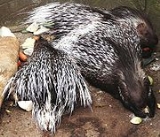
List of mammals of Armenia
Encyclopedia
This is a list of the mammal species recorded in Armenia. There are 62 mammal species in Armenia
, of which 1 is critically endangered, 2 are endangered, 8 are vulnerable, and 4 are near-threatened.
The following tags are used to highlight each species' conservation status as assessed by the IUCN
:
Some species were assessed using an earlier set of criteria. Species assessed using this system have the following instead of Near Threatened and Least Concern categories:
Order: Rodent
----

 Rodents make up the largest order of mammals, with over 40 percent of mammalian species. They have two incisor
Rodents make up the largest order of mammals, with over 40 percent of mammalian species. They have two incisor
s in the upper and lower jaw which grow continually and must be kept short by gnawing. Most rodents are small though the capybara
can weigh up to 45 kg (100 lb).
Order: Lagomorpha
----
The lagomorphs comprise two families, Leporidae
(hare
s and rabbit
s), and Ochotonidae (pika
s). Though they can resemble rodent
s, and were classified as a superfamily
in that order until the early 20th century, they have since been considered a separate order. They differ from rodents in a number of physical characteristics, such as having four incisors in the upper jaw rather than two.
The order Erinaceomorpha contains a single family, Erinaceidae, which comprise the hedgehog
s and gymnure
s. The hedgehogs are easily recognised by their spines while gymnures look more like large rats.
Order: Soricomorpha
----
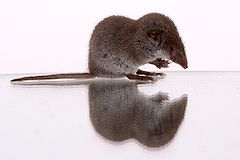
 The "shrew-forms" are insectivorous mammals. The shrews and soledons closely resemble mice while the moles are stout bodied burrowers.
The "shrew-forms" are insectivorous mammals. The shrews and soledons closely resemble mice while the moles are stout bodied burrowers.
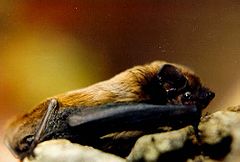 The bats' most distinguishing feature is that their forelimbs are developed as wings, making them the only mammals in the world naturally capable of flight. Bat species account for about 20% of all mammals.
The bats' most distinguishing feature is that their forelimbs are developed as wings, making them the only mammals in the world naturally capable of flight. Bat species account for about 20% of all mammals.
Order: Carnivora
----
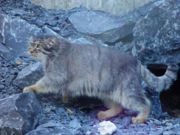
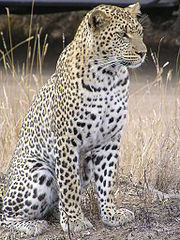
.jpg)
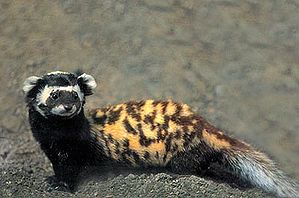
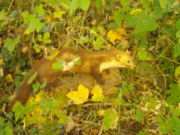 There are over 260 species of carnivorans, the majority of which feed primarily on meat. They have a characteristic skull shape and dentition.
There are over 260 species of carnivorans, the majority of which feed primarily on meat. They have a characteristic skull shape and dentition.

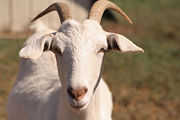 The even-toed ungulates are ungulate
The even-toed ungulates are ungulate
s whose weight is borne about equally by the third and fourth toes, rather than mostly or entirely by the third as in perissodactyls. There are about 220 artiodactyl species, including many that are of great economic importance to human
s.
Armenia
Armenia , officially the Republic of Armenia , is a landlocked mountainous country in the Caucasus region of Eurasia...
, of which 1 is critically endangered, 2 are endangered, 8 are vulnerable, and 4 are near-threatened.
The following tags are used to highlight each species' conservation status as assessed by the IUCN
World Conservation Union
The International Union for Conservation of Nature and Natural Resources is an international organization dedicated to finding "pragmatic solutions to our most pressing environment and development challenges." The organization publishes the IUCN Red List, compiling information from a network of...
:
| EX | Extinct | No reasonable doubt that the last individual has died. |
| EW | Extinct in the wild | Known only to survive in captivity or as a naturalized populations well outside its previous range. |
| CR | Critically Endangered | The species is in imminent risk of extinction in the wild. |
| EN | Endangered | The species is facing an extremely high risk of extinction in the wild. |
| VU | Vulnerable | The species is facing a high risk of extinction in the wild. |
| NT | Near Threatened | The species does not meet any of the criteria that would categorise it as risking extinction but it is likely to do so in the future. |
| LC | Least Concern | There are no current identifiable risks to the species. |
| DD | Data Deficient | There is inadequate information to make an assessment of the risks to this species. |
Some species were assessed using an earlier set of criteria. Species assessed using this system have the following instead of Near Threatened and Least Concern categories:
| LR/cd | Lower Risk/conservation dependent | Species which were the focus of conservation programmes and may have moved into a higher risk category if that programme was discontinued. |
| LR/nt | Lower Risk/near threatened | Species which are close to being classified as Vulnerable but are not the subject of conservation programmes. |
| LR/lc | Lower Risk/least concern | Species for which there are no identifiable risks. |
Order: RodentRodentRodentia is an order of mammals also known as rodents, characterised by two continuously growing incisors in the upper and lower jaws which must be kept short by gnawing....
ia (rodents)
----

Incisor
Incisors are the first kind of tooth in heterodont mammals. They are located in the premaxilla above and mandible below.-Function:...
s in the upper and lower jaw which grow continually and must be kept short by gnawing. Most rodents are small though the capybara
Capybara
The capybara , also known as capivara in Portuguese, and capibara, chigüire in Venezuela, Colombia, and Ecuador ronsoco in Peru, chigüiro, and carpincho in Spanish, is the largest living rodent in the world. Its closest relatives are agouti, chinchillas, coyphillas, and guinea pigs...
can weigh up to 45 kg (100 lb).
- Suborder: HystricomorphaHystricomorphaThe term Hystricomorpha has had many definitions throughout its history. In the broadest sense it refers to any rodent with a hystricomorphous zygomasseteric system. This includes the Hystricognathi, Ctenodactylidae, Anomaluridae, and Pedetidae...
- Family: Hystricidae (Old World porcupines)
-
- Genus: HystrixHystrixHystrix is a genus of porcupine that contains what are the best known and most distinctive of the Old World porcupines.-Species:*Genus Hystrix**Subgenus Thecurus***Hystrix crassispinis - Thick-spined Porcupine...
- Indian PorcupineIndian PorcupineThe Indian Crested Porcupine , or Indian Porcupine, is a member of the Old World porcupines. It is quite an adaptable rodent, found throughout southern Asia and the Middle East. It is tolerant of several different habitats: mountains, tropical and subtropical grasslands, scrublands, and forests...
Hystrix indica LR/lc
- Indian Porcupine
- Genus: Hystrix
-
- Family: Hystricidae (Old World porcupines)
- Suborder: SciurognathiSciurognathiSciurognathi is a suborder of rodents that includes squirrels, chipmunks, beavers, and many types of mice. The group is characterized by a specific shape to the lower jaw. In sciurognaths, the angular process of the jaw is in the same plane as the root of the incisors...
- Family: Sciuridae (squirrels)
- Subfamily: SciurinaeSciurinaeThe Sciurinae is a subfamily of squirrels in the . It unites the flying squirrels with certain related tree squirrels. Older sources place the flying squirrels in a separate subfamily and unite all remaining sciurids into the subfamily Sciurinae, but this has been strongly refuted by genetic...
- Tribe: SciuriniSciuriniSciurini is a tribe that includes about forty species of squirrels, mostly from the Americas. It includes five living genera—the American dwarf squirrels, Microsciurus; the Bornean Rheithrosciurus; the widespread American and Eurasian tree squirrels of the genus Sciurus, which includes some of the...
- Genus: SciurusSciurusThe genus Sciurus contains most of the common, bushy-tailed squirrels in North America, Europe, temperate Asia, Central America and South America.-Species:There are 30 species.Genus Sciurus - Tree squirrels*Subgenus Sciurus...
- Caucasian SquirrelCaucasian SquirrelThe Caucasian squirrel is a tree squirrel in the genus Sciurus endemic to Armenia, Azerbaijan, Georgia, Greece, Iran, Iraq, Israel, Jordan, Lebanon, Syria, and Turkey. Its natural habitat is temperate broadleaf and mixed forests....
Sciurus anomalus LR/nt
- Caucasian Squirrel
- Genus: Sciurus
- Tribe: Sciurini
- Subfamily: XerinaeXerinaeXerinae is a subfamily of squirrels, many of which are highly terrestrial. It includes the tribes Marmotini , Xerini , and Protoxerini .-References:* Thorington, R. W. and R. S. Hoffmann. 2005. Family Sciuridae. Pp 754-818 in Wilson, E. D...
- Tribe: Marmotini
- Genus: Marmota
- Long-tailed MarmotLong-tailed MarmotThe long-tailed marmot or golden marmot is a species of marmot in the Sciuridae family.It is found in Afghanistan, Armenia, Azerbaijan, China, India, Kazakhstan, Kyrgyzstan, Pakistan, Tajikistan, and Uzbekistan....
Marmota caudata LR/nt
- Long-tailed Marmot
- Genus: SpermophilusSpermophilusSpermophilus is a genus of ground squirrels in the family Sciuridae. The majority of ground squirrel species, over 40 in total, are usually placed in this genus...
- Asia Minor Ground SquirrelAsia Minor Ground SquirrelThe Asia Minor ground squirrel , or Anatolian souslik, is a species of rodent in the Sciuridae family. It is found in Armenia, Iran, and Turkey...
Spermophilus xanthoprymnus LR/lc
- Asia Minor Ground Squirrel
- Genus: Marmota
- Tribe: Marmotini
- Subfamily: Sciurinae
- Family: Gliridae (dormice)
- Subfamily: GlirinaeGlirinaeGlirinae is a subfamily of dormice .It contains two extant genera, each one having one species:Subfamily Glirinae*Genus Glirulus**Japanese Dormouse, Glirulus japonicus*Genus Glis**Edible Dormouse, Glis glis...
- Genus: Glis
- Edible dormouseEdible dormouseThe edible dormouse or fat dormouse is a large dormouse and the only living species in the genus Glis.-Description:...
Glis glis LR/nt
- Edible dormouse
- Genus: Glis
- Subfamily: Glirinae
- Family: DipodidaeDipodidaeThe Dipodidae, or dipodids, are a family of rodents found across the northern hemisphere. This family includes over 50 species among the 16 genera....
(jerboas)- Subfamily: AllactaginaeAllactaginaeAllactaginae is a subfamily of rodents.- Classification :Subfamily Allactaginae*Genus Allactaga**incertae sedis***Allactaga toussi**Subgenus Allactaga***Small Five-toed Jerboa, Allactaga elater...
- Genus: AllactagaAllactagaThe genus Allactaga contains the four and five-toed jerboas of Asia.-Characteristics:These are hopping rodents of desert and semi-arid regions with long ears, tails and feet. All members of the genus have five toes except for a single species, the Four-toed Jerboa, Allactaga tetradactyla of...
- Small Five-toed JerboaSmall Five-toed JerboaThe Small Five-toed Jerboa is a species of rodent in the Dipodidae family.It is found in Afghanistan, Armenia, Azerbaijan, China, Georgia, Iran, Kazakhstan, Pakistan, Russia, Tajikistan, Turkey, and Turkmenistan.-References:...
Allactaga elater LR/lc
- Small Five-toed Jerboa
- Genus: Allactaga
- Subfamily: Sicistinae
- Genus: Sicista
- Armenian Birch MouseArmenian Birch MouseThe Armenian Birch Mouse is a species of rodent in the Dipodidae family.-Description:It is a small rodent, like the mouse, the average weight of 10 g and up to 9 cm long, excluding the semi-prehensile tail, which slightly exceeds the length of the body...
Sicista armenica CR
- Armenian Birch Mouse
- Genus: Sicista
- Subfamily: Allactaginae
- Family: SpalacidaeSpalacidaeThe Spalacidae, or spalacids are a family of rodents in the large and complex superfamily Muroidea. They are native to eastern Asia, the Horn of Africa, the Middle East, and south-eastern Europe. It includes the blind mole rats, bamboo rats, root rats, and zokors...
- Subfamily: Spalacinae
- Genus: Nannospalax
- Nehring's Bilind Mole Rat Nannospalax nehringi LR/lc
- Genus: Nannospalax
- Subfamily: Spalacinae
- Family: CricetidaeCricetidaeThe Cricetidae are a family of rodents in the large and complex superfamily Muroidea. It includes true hamsters, voles, lemmings, and New World rats and mice...
- Subfamily: Cricetinae
- Genus: MesocricetusMesocricetusMesocricetus is a genus of Old World hamsters, including the Golden hamster or Syrian hamster, the first hamster to be introduced as a domestic pet and still the most popular species for that purpose....
- Turkish hamsterTurkish HamsterThe Turkish hamster , also referred to as Brandt’s Hamster, The Azerbaijani Hamster,or Avurtlak, is a species of hamster native to Turkey, Armenia and other surrounding nations...
Mesocricetus brandti LR/lc
- Turkish hamster
- Genus: Mesocricetus
- Subfamily: ArvicolinaeArvicolinaeThe Arvicolinae are a subfamily of rodents that includes the voles, lemmings, and muskrats. They are most closely related to the other subfamilies in the Cricetidae . Some authorities place the subfamily Arvicolinae in the family Muridae along with all other members of the superfamily Muroidea...
- Genus: ChionomysChionomysChionomys is a genus of rodent in the family Cricetidae.It contains the following species:* Caucasian Snow Vole * European Snow Vole * Robert's Snow Vole -References:...
- Snow Vole Chionomys nivalis LR/nt
- Genus: EllobiusEllobiusEllobius is a genus of rodent in the family Cricetidae.It contains the following species:* Alai Mole Vole * Southern Mole Vole * Transcaucasian Mole Vole...
- Transcaucasian Mole VoleTranscaucasian Mole VoleThe Transcaucasian Mole Vole is a species of rodent in the family Cricetidae.It is found in Armenia, Azerbaijan, Georgia, Iran, and Turkey.-References:...
Ellobius lutescens LR/lc
- Transcaucasian Mole Vole
- Genus: MicrotusMicrotusThe genus Microtus is a group of voles found in North America, Europe and northern Asia. The genus name refers to the small ears of these animals. There are 62 species in the genus....
- Altai Vole Microtus obscurus LR/lc
- Genus: Chionomys
- Subfamily: Cricetinae
- Family: MuridaeMuridaeMuridae is the largest family of mammals. It contains over 600 species found naturally throughout Eurasia, Africa, and Australia. They have been introduced worldwide. The group includes true mice and rats, gerbils, and relatives....
(mice, rats, voles, gerbils, hamsters, etc.)- Subfamily: Gerbillinae
- Genus: MerionesMeriones (genus)Meriones is a rodent genus that includes the gerbil most commonly kept as a pet, Meriones unguiculatus. The genus contains most animals referred to as jirds, but members of the genera Sekeetamys, Brachiones, and sometimes Pachyuromys are also known as jirds. The distribution of Meriones ranges...
- Dahl's JirdDahl's JirdDahl's Jird is a species of rodent in the family Muridae.It is found only in Armenia and the neighboring Agri province of Turkey.-References:* Tchabovsky, A. 1996. . Downloaded on 19 July 2007....
Meriones dahli EN - Persian JirdPersian JirdThe Persian jird is a species of rodent in the family Muridae found in Afghanistan, Armenia, Azerbaijan, Iran, Iraq, Pakistan, Turkey, and Turkmenistan....
Meriones persicus LR/lc - Tristram's JirdTristram's JirdTristram's Jird is a species of rodent in the family Muridae. It is found in Armenia, Azerbaijan, Iran, Iraq, Israel, Jordan, Lebanon, Syria, and Turkey.-References:* Baillie, J. 1996. . Downloaded on 19 July 2007....
Meriones tristrami LR/lc - Vinogradov's JirdVinogradov's JirdVinogradov's Jird is a species of rodent in the family Muridae.It is found in Armenia, Azerbaijan, Iran, Syria, and Turkey.-References:* Baillie, J. 1996. . Downloaded on 19 July 2007....
Meriones vinogradovi LR/lc
- Dahl's Jird
- Genus: Meriones
- Subfamily: MurinaeMurinaeThe Old World rats and mice, part of the subfamily Murinae in the family Muridae, comprise at least 519 species. This subfamily is larger than all mammal families except the Cricetidae and Muridae, and is larger than all mammal orders except the bats and the remainder of the...
- Genus: ApodemusApodemusApodemus is the genus of Muridae which contains the Eurasian field mice. Related to the Ryūkyū spiny rats and the prehistoric Rhagamys – and far more distantly to Mus and Malacomys –, it includes the following species:*Striped Field Mouse, Apodemus agrarius*Alpine Field Mouse, Apodemus...
- Striped Field MouseStriped Field MouseThe Striped Field Mouse is a rodent in the family Muridae. The range of this species stretches from Eastern Europe to Japan, including Taiwan and Siberia....
Apodemus agrarius LR/lc - Yellow-breasted Field Mouse Apodemus fulvipectus LR/lc
- Black Sea Field MouseBlack Sea Field MouseThe Black Sea Field Mouse is a species of rodent in the family Muridae.It is found in Armenia, Azerbaijan, Georgia, possibly Iran , Iraq, Russian Federation, and Turkey.-References:...
Apodemus ponticus LR/lc - Ural Field MouseUral Field MouseThe Ural Field Mouse is a species of rodent in the family Muridae. It is also known as the Pygmy Field Mouse. It is found in Armenia, Austria, Azerbaijan, Belarus, Bulgaria, China, Croatia, Czech Republic, Estonia, Georgia, Hungary, Kazakhstan, Latvia, Liechtenstein, Lithuania, Mongolia,...
Apodemus uralensis LR/lc
- Striped Field Mouse
- Genus: MicromysMicromysMicromys is a genus of small rodents in the subfamily Murinae without close relations to any other murine genus. It contains two living species: the widespread Eurasian harvest mouse of much of Europe and Asia and the more restricted Micromys erythrotis of Vietnam, southern China, and perhaps...
- Harvest Mouse Micromys minutus LR/nt
- Genus: Apodemus
- Subfamily: Gerbillinae
- Family: Sciuridae (squirrels)
Order: LagomorphaLagomorphaThe lagomorphs are the members of the taxonomic order Lagomorpha, of which there are two living families, the Leporidae , and the Ochotonidae...
(lagomorphs)
----The lagomorphs comprise two families, Leporidae
Leporidae
Leporids are the approximately 50 species of rabbits and hares which form the family Leporidae. The leporids, together with the pikas, constitute the mammalian order Lagomorpha. Leporids differ from pikas in having short furry tails, and elongated ears and hind legs...
(hare
Hare
Hares and jackrabbits are leporids belonging to the genus Lepus. Hares less than one year old are called leverets. Four species commonly known as types of hare are classified outside of Lepus: the hispid hare , and three species known as red rock hares .Hares are very fast-moving...
s and rabbit
Rabbit
Rabbits are small mammals in the family Leporidae of the order Lagomorpha, found in several parts of the world...
s), and Ochotonidae (pika
Pika
The pika is a small mammal, with short limbs, rounded ears, and short tail. The name pika is used for any member of the Ochotonidae, a family within the order of lagomorphs, which also includes the Leporidae . One genus, Ochotona, is recognised within the family, and it includes 30 species...
s). Though they can resemble rodent
Rodent
Rodentia is an order of mammals also known as rodents, characterised by two continuously growing incisors in the upper and lower jaws which must be kept short by gnawing....
s, and were classified as a superfamily
Taxonomic rank
In biological classification, rank is the level in a taxonomic hierarchy. Examples of taxonomic ranks are species, genus, family, and class. Each rank subsumes under it a number of less general categories...
in that order until the early 20th century, they have since been considered a separate order. They differ from rodents in a number of physical characteristics, such as having four incisors in the upper jaw rather than two.
- Family: Ochotonidae (pikas)
- Genus: Ochotona
- Afghan PikaAfghan PikaThe Afghan Pika is a species of mammal in the Ochotonidae family. It is found in Afghanistan, Armenia, Iran, Pakistan, and Turkmenistan....
Ochotona rufescens LR/lc
- Afghan Pika
- Genus: Ochotona
Order: Erinaceomorpha (hedgehogs and gymnures)
----The order Erinaceomorpha contains a single family, Erinaceidae, which comprise the hedgehog
Hedgehog
A hedgehog is any of the spiny mammals of the subfamily Erinaceinae and the order Erinaceomorpha. There are 17 species of hedgehog in five genera, found through parts of Europe, Asia, Africa, and New Zealand . There are no hedgehogs native to Australia, and no living species native to the Americas...
s and gymnure
Gymnure
The gymnure, also called a hairy hedgehog or moonrat, is a type of mammal belonging to the subfamily Galericinae, in the family Erinaceidae and the order Erinaceomorpha...
s. The hedgehogs are easily recognised by their spines while gymnures look more like large rats.
- Family: ErinaceidaeErinaceidaeErinaceidae is the only living family in the order Erinaceomorpha, which has recently been subsumed with Soricomorpha into the order Eulipotyphla...
(hedgehogs)- Subfamily: Erinaceinae
- Genus: ErinaceusErinaceusErinaceus is a genus of European hedgehog from the family of Erinaceidae. There are four main species of Erinaceus. The range is all across Europe, throughout the Middle East, parts of Russia, and extending to northern China...
- Southern White-breasted Hedgehog Erinaceus concolor LR/lc
- Genus: Erinaceus
- Subfamily: Erinaceinae
Order: SoricomorphaSoricomorphaThe order Soricomorpha is taxon within the class of mammals. In previous years it formed a significant group within the former order Insectivora...
(shrews, moles, and soledons)
----

- Family: Soricidae (shrews)
- Subfamily: Crocidurinae
- Genus: CrociduraCrociduraThe genus Crocidura is one of nine genus of the shrew subfamily Crocidurinae. Members of the genus are commonly called white-toothed shrews or musk shrews, although both also apply to all of the species in the subfamily. With 182 species, Crocidura contains the largest number of species of any...
- Armenian ShrewArmenian ShrewThe Armenian Shrew is a species of mammal in the Soricidae family. It is endemic to Armenia....
Crocidura armenica DD - Gueldenstaedt's ShrewGueldenstaedt's ShrewThe Gueldenstaedt's Shrew is a species of mammal in the Soricidae family. It is found in Armenia, Azerbaijan, China, Georgia , Greece, Kazakhstan, Kyrgyzstan, Russia, Taiwan, Turkey, and Uzbekistan.-References:...
Crocidura gueldenstaedtii LR/lc - Bicolored ShrewBicolored ShrewThe Bicolored Shrew or Bicoloured White-toothed Shrew is a species of mammal in the Soricidae family. It is found in Armenia, Azerbaijan, Belgium, Bosnia and Herzegovina, Bulgaria, Croatia, Czech Republic, Georgia , Germany, Greece, Hungary, Iran, Iraq, Israel, Italy, Lebanon, Liechtenstein,...
Crocidura leucodon LR/lc - Lesser White-toothed ShrewLesser white-toothed shrewThe Lesser White-toothed Shrew is a tiny shrew with a widespread distribution in Africa, Asia and Europe, but not in most of Spain, north–west France and mainland Great Britain. Its preferred habitat is scrub and gardens and it feeds on insects, worms, slugs, snails and small mice...
Crocidura suaveolens LR/lc
- Armenian Shrew
- Genus: Crocidura
- Subfamily: Soricinae
- Tribe: NectogaliniNectogaliniNectogalini is a tribe of Old World water shrews within the family Soricidae. As of late 2007, it consisted of six extant genera and 25 species, with some of the latter being further divided into subspecies.-Adaptation to semi-aquatic life:...
- Genus: NeomysNeomysThe genus Neomys is a group of three Eurasian water shrews from the subfamily Soricinae of the family Soricidae. These shrews are found in most of Europe, and parts of Northern Asia as well as Turkey and Iran...
- Transcaucasian Water ShrewTranscaucasian Water ShrewThe Transcaucasian Water Shrew is a species of mammal in the Soricidae family. It is found in Armenia, Azerbaijan, Georgia , possibly Iran , and possibly Turkey.-References:...
Neomys schelkovnikovi LR/lc
- Transcaucasian Water Shrew
- Genus: Neomys
- Tribe: Soricini
- Genus: SorexSorexThe genus Sorex includes many of the common shrews of Eurasia and North America. Members of this genus, known as long-tailed shrews, are the only members of the tribe Soricini of the subfamily Soricinae...
- Eurasian Pygmy ShrewEurasian pygmy shrewThe Eurasian Pygmy Shrew , often known simply as the Pygmy Shrew, is a widespread shrew of northern Eurasia. It is the only shrew native to Ireland....
Sorex minutus LR/lc - Radde's ShrewRadde's ShrewRadde's Shrew is a species of mammal in the Soricidae family. It is found in Armenia, Azerbaijan, Georgia, Russia, and Turkey.-References:* Insectivore Specialist Group 1996. . Downloaded on 30 July 2007....
Sorex raddei LR/lc - Caucasian Pygmy ShrewCaucasian Pygmy ShrewThe Caucasian Pygmy Shrew or Ukrainian Shrew is a species of mammal in the Soricidae family. It is found in Armenia, Azerbaijan, Georgia , Russia, Ukraine, possibly Iran , and possibly Turkey....
Sorex volnuchini LR/lc
- Eurasian Pygmy Shrew
- Genus: Sorex
- Tribe: Nectogalini
- Subfamily: Crocidurinae
Order: Chiroptera (bats)
----
- Family: Vespertilionidae
- Subfamily: Myotinae
- Genus: Myotis
- Geoffroy's BatGeoffroy's BatGeoffroy's Bat is a species of vesper bat in the Vespertilionidae family.It can be found in the following countries: Afghanistan, Algeria, Armenia, Austria, Azerbaijan, Belgium, Bosnia and Herzegovina, Bulgaria, Croatia, Czech Republic, France, Georgia, Germany, Greece, Hungary, Iran, Israel,...
Myotis emarginatus VU - Whiskered batWhiskered batThe whiskered bats Myotis mystacinus and related species, are small European bats with long fur. Although uncommon, M. mystacinus is often found around human habitation and around water; it is similar to Brandt's bat Myotis brandtii, from which it was distinguished as a separate species only in...
Myotis mystacinus LR/lc - Natterer's batNatterer's batNatterer's bat is a European bat with pale wings. It has brown fur, also seen on the leg wing membrane, tending to white on its underside...
Myotis nattereri LR/lc - Schaub's MyotisSchaub's MyotisSchaub's Myotis is a species of vesper bat in the Vespertilionidae family.It is found in Armenia and Iran and known from fossils from Hungary. It is related to Myotis nattereri.-References:...
Myotis schaubi EN
- Geoffroy's Bat
- Genus: Myotis
- Subfamily: VespertilioninaeVespertilioninaeVespertilioninae is a subfamily of Vesper Bats from the family Vespertilionidae.-Classification:Subfamily Vespertilioninae*Tribe Eptesicini**Genus Arielulus***Collared Pipistrelle, Arielulus aureocollaris...
- Genus: BarbastellaBarbastellaBarbastella is a small genus of vespertilionid bats. There are three described species in this genus.-Species:Barbastella is a small genus of vespertilionid bats. There are three described species in this genus.-Species:...
- BarbastelleBarbastelleThe Barbastelle , also known as the Western Barbastelle, is a European bat. It has a short nose, small eyes and wide ears.It is rare throughout its range...
Barbastella barbastellus VU
- Barbastelle
- Genus: NyctalusNyctalusThe bat genus Nyctalus are members of the family Vespertilionidae or sometimes Evening bats. They are distributed in the temperate and subtropical areas of Europe, Asia and North Africa.There are eight species within this genus:...
- Greater Noctule batGreater Noctule batThe Greater Noctule bat is a rare mammal found in Europe, West Asia, and North Africa. It is the largest and least studied bat in Europe with a wingspan of up to 46 centimeters and is one of the few bat species to feed on passerine birds. Greater Noctule bat is the only bat species to hunt birds...
Nyctalus lasiopterus LR/nt - Lesser NoctuleLesser NoctuleThe Lesser Noctule or Leisler's Bat is a species of bat belonging to the vesper bat family, Vespertilionidae.-Description:...
Nyctalus leisleri LR/nt
- Greater Noctule bat
- Genus: Barbastella
- Subfamily: Miniopterinae
- Genus: MiniopterusMiniopterusMiniopterus is a genus of bats and the only genus of the family Miniopteridae. The genus was previously placed in its own subfamily, Miniopterinae, of the vesper bat family, but is now classified in its own family....
- Schreiber's Long-fingered Bat Miniopterus schreibersii LC
- Genus: Miniopterus
- Subfamily: Myotinae
- Family: Rhinolophidae
- Subfamily: Rhinolophinae
- Genus: Rhinolophus
- Blasius's Horseshoe BatBlasius's Horseshoe BatBlasius's Horseshoe Bat is a species of bat in the Rhinolophidae family found throughout large parts of the Mediterranean, Middle East and Northern Africa.-Physical appearance:...
Rhinolophus blasii NT - Mediterranean Horseshoe BatMediterranean Horseshoe BatThe Mediterranean Horseshoe Bat is a species of bat in the Rhinolophidae family. It is found in the Mediterranean region and balkan peninsula, as well as parts of Italy.-Physical characteristics:...
Rhinolophus euryale VU - Greater Horseshoe BatGreater Horseshoe BatThe Greater Horseshoe Bat is a European bat of the Rhinolophus genus. Its distribution covers Europe, Africa, South Asia and Australia. It is the largest of the European Horseshoe Bats and is thus easily distinguished from other species...
Rhinolophus ferrumequinum LR/nt - Lesser horseshoe batLesser horseshoe batThe Lesser Horseshoe Bat , is a type of European bat related to but smaller than its cousin, the Greater Horseshoe Bat...
Rhinolophus hipposideros LC - Mehely's Horseshoe BatMehely's Horseshoe BatMehely's Horseshoe Bat is a species of bat in the Rhinolophidae family found in eastern Europe and parts of the Middle East.-Physical Appearance:...
Rhinolophus mehelyi VU
- Blasius's Horseshoe Bat
- Genus: Rhinolophus
- Subfamily: Rhinolophinae
Order: CarnivoraCarnivoraThe diverse order Carnivora |Latin]] carō "flesh", + vorāre "to devour") includes over 260 species of placental mammals. Its members are formally referred to as carnivorans, while the word "carnivore" can refer to any meat-eating animal...
(carnivorans)
----

.jpg)


- Suborder: FeliformiaFeliformiaThe Feliformia are a suborder within the order Carnivora and includes cats , hyenas, mongooses, civets and related taxa. The other suborder of Carnivora is Caniformia...
- Family: FelidaeFelidaeFelidae is the biological family of the cats; a member of this family is called a felid. Felids are the strictest carnivores of the thirteen terrestrial families in the order Carnivora, although the three families of marine mammals comprising the superfamily pinnipedia are as carnivorous as the...
(cats)- Subfamily: FelinaeFelinaeFelinae is a subfamily of the family Felidae which includes the genera and species listed below. Most are small to medium-sized cats, although the group does include some larger animals, such as the Cougar and Cheetah....
- Genus: FelisFelisFelis is a genus of cats in the family Felidae, including the familiar domestic cat and its closest wild relatives. The wild species are distributed widely across Europe, southern and central Asia, and Africa; the domestic cat has been introduced worldwide.Members of the genus Felis are all small...
- WildcatWildcatWildcat is a small felid native to Europe, the western part of Asia, and Africa.-Animals:Wildcat may also refer to members of the genus Lynx:...
Felis silvestris LC - Pallas's Cat Felis manul NT
- Wildcat
- Genus: LynxLynxA lynx is any of the four Lynx genus species of medium-sized wildcats. The name "lynx" originated in Middle English via Latin from Greek word "λύγξ", derived from the Indo-European root "*leuk-", meaning "light, brightness", in reference to the luminescence of its reflective eyes...
- Eurasian LynxEurasian LynxThe Eurasian lynx is a medium-sized cat native to European and Siberian forests, South Asia and East Asia. It is also known as the European lynx, common lynx, the northern lynx, and the Siberian or Russian lynx...
Lynx lynx NT
- Eurasian Lynx
- Genus: Felis
- Subfamily: PantherinaePantherinaePantherinae is the subfamily of the family Felidae, which includes the genera Panthera, Uncia and Neofelis.The divergence of Pantherinae from Felinae has been ranked between six and ten million years ago. DNA analysis suggests that the snow leopard Uncia uncia is basal to the entire Pantherinae and...
- Genus: PantheraPantheraPanthera is a genus of the family Felidae , which contains four well-known living species: the tiger, the lion, the jaguar, and the leopard. The genus comprises about half of the Pantherinae subfamily, the big cats...
- LeopardLeopardThe leopard , Panthera pardus, is a member of the Felidae family and the smallest of the four "big cats" in the genus Panthera, the other three being the tiger, lion, and jaguar. The leopard was once distributed across eastern and southern Asia and Africa, from Siberia to South Africa, but its...
Panthera pardus LC
- Leopard
- Genus: Panthera
- Subfamily: Felinae
- Family: Hyaenidae (hyaenas)
- Genus: HyaenaHyaenaFor the Siouxsie and the Banshees album, see Hyæna.For the group of animals commonly known as "hyaena", see Hyena.Hyaena is a genus comprising two of the living species of hyenas: the striped hyena from western Asia and northern Africa and the brown hyena from southern Africa...
- Striped HyenaStriped HyenaThe Striped Hyena is a species of true hyena native to North and East Africa, the Caucasus, the Middle East, Middle and Central Asia and the Indian Subcontinent...
Hyaena hyaena LR/nt
- Striped Hyena
- Genus: Hyaena
- Family: Felidae
- Suborder: CaniformiaCaniformiaCaniformia, or Canoidea , is a suborder within the order Carnivora. They typically possess a long snout and non-retractile claws . The Pinnipedia evolved from caniform ancestors and are accordingly assigned to this group...
- Family: CanidaeCanidaeCanidae is the biological family of carnivorous and omnivorous mammals that includes wolves, foxes, jackals, coyotes, and domestic dogs. A member of this family is called a canid . The Canidae family is divided into two tribes: Canini and Vulpini...
(dogs, foxes)- Genus: VulpesVulpesVulpes is a genus of the Canidae family. Its members are referred to as 'true foxes', although there are species in other genera whose common names include the word 'fox'....
- Red FoxRed FoxThe red fox is the largest of the true foxes, as well as being the most geographically spread member of the Carnivora, being distributed across the entire northern hemisphere from the Arctic Circle to North Africa, Central America, and the steppes of Asia...
Vulpes vulpes LC
- Red Fox
- Genus: CanisCanisCanis is a genus containing 7 to 10 extant species, including dogs, wolves, coyotes, and jackals, and many extinct species.-Wolves, dogs and dingos:Wolves, dogs and dingos are subspecies of Canis lupus...
- Gray WolfGray WolfThe gray wolf , also known as the wolf, is the largest extant wild member of the Canidae family...
Canis lupus LC
- Gray Wolf
- Genus: Vulpes
- Family: MustelidaeMustelidaeMustelidae , commonly referred to as the weasel family, are a family of carnivorous mammals. Mustelids are diverse and the largest family in the order Carnivora, at least partly because in the past it has been a catch-all category for many early or poorly differentiated taxa...
(mustelids)- Genus: Mustela
- Steppe PolecatSteppe polecatThe steppe polecat , also known as the white or masked polecat, is a species of Mustelid native to Central and Eastern Europe and Central Asia...
Mustela eversmannii LR/lc - Least WeaselLeast WeaselThe least weasel is the smallest member of the Mustelidae , native to Eurasia, North America and North Africa, though it has been introduced elsewhere. It is classed as Least Concern by the IUCN, due to its wide distribution and presumably large population...
Mustela nivalis LR/lc
- Steppe Polecat
- Genus: Vormela
- Marbled PolecatMarbled polecatThe marbled polecat is a small mammal belonging to the monotypic genus Vormela within the Mustelinae subfamily. Vormela is from the German word Würmlein, which means "little Worm". The term peregusna comes from pereguznya, which is Ukrainian for polecat...
Vormela peregusna LR/lc
- Marbled Polecat
- Genus: Martes
- Beech MartenBeech MartenThe beech marten , also known as the stone marten or white breasted marten, is a species of marten native to much of Europe and Central Asia, though it has established a feral population in North America. It is listed as Least Concern by the IUCN on account of its wide distribution, its large...
Martes foina LR/lc
- Beech Marten
- Genus: MelesMeles (genus)Meles is a genus of badgers, containing three living species, the Japanese Badger , Asian Badger , and European Badger ....
- Eurasian BadgerEurasian BadgerThe European Badger is a species of badger of the genus Meles, native to almost all of Europe. It is classed as Least Concern for extinction by the IUCN, due to its wide distribution and large population....
Meles meles LR/lc
- Eurasian Badger
- Genus: LutraLutraLutra is a genus of otters.*Lutra nippon - Japanese otter*Lutra sumatrana - Hairy-nosed otter*Lutra lutra - European otter-Habitat:Lutra are semi-aquatic mammals and therefore need to be well-adapted to both water and land...
- European OtterEuropean OtterThe European Otter , also known as the Eurasian otter, Eurasian river otter, common otter and Old World otter, is a European and Asian member of the Lutrinae or otter subfamily, and is typical of freshwater otters....
Lutra lutra NT
- European Otter
- Genus: Mustela
- Family: Canidae
Order: Artiodactyla (even-toed ungulates)
----

Ungulate
Ungulates are several groups of mammals, most of which use the tips of their toes, usually hoofed, to sustain their whole body weight while moving. They make up several orders of mammals, of which six to eight survive...
s whose weight is borne about equally by the third and fourth toes, rather than mostly or entirely by the third as in perissodactyls. There are about 220 artiodactyl species, including many that are of great economic importance to human
Human
Humans are the only living species in the Homo genus...
s.
- Family: Cervidae (deer)
- Subfamily: CervinaeCervinaeCervinae or the Old World deer , is a subfamily of deer. Alternatively, they're known as the Plesiometacarpal deer, due to their ankle structure being different from the Telemetecarpal deer of Capreolinae-Classification and Species:The list is based on the studies of Randi, Mucci, Claro-Hergueta,...
- Genus: CervusCervusCervus is a genus of deer that primarily are native to Eurasia, although one species occurs in northern Africa and another in North America. In addition to the species presently placed in this genus, it has included a whole range of other species now commonly placed in other genera, but some of...
- Red DeerRed DeerThe red deer is one of the largest deer species. Depending on taxonomy, the red deer inhabits most of Europe, the Caucasus Mountains region, Asia Minor, parts of western Asia, and central Asia. It also inhabits the Atlas Mountains region between Morocco and Tunisia in northwestern Africa, being...
Cervus elaphus LR/lc
- Red Deer
- Genus: Cervus
- Subfamily: Cervinae
- Family: Bovidae (cattle, antelope, sheep, goats)
- Subfamily: AntilopinaeAntilopinaeAntilopinae is a subfamily of Bovidae. The gazelles, blackbucks, springboks, gerenuks, dibatags and Central Asian gazelles are often referred to as "True Antelopes" and are usually the sole representatives of the Antilopinae...
- Genus: Gazella
- Goitered GazelleGoitered GazelleThe Goitered, Black-tailed or Persian gazelle is a gazelle found in the north part of Azerbaijan, in a large area of central Asia, including part of Iran and southern west Pakistan in the western end of the range, as well as the Gobi desert...
Gazella subgutturosa VU
- Goitered Gazelle
- Genus: Gazella
- Subfamily: Caprinae
- Genus: CapraCapra (genus)Capra is a genus of mammals, the goats or wild goats, composed of up to nine species including the wild goat, the markhor and several species known as ibex....
- Wild GoatWild GoatThe wild goat is a widespread species of goat, with a distribution ranging from Europe and Asia Minor to central Asia and the Middle East. It is the ancestor of the domestic goat.-Social structure:...
Capra aegagrus VU
- Wild Goat
- Genus: OvisOvisOvis is a genus of mammals, part of the goat-antelope subfamily of the ruminant family Bovidae. Its five or more highly gregarious species are known as sheep...
- ArgaliArgaliThe argali, or the mountain sheep is a wild sheep, which roams the highlands of Central Asia . It is the biggest wild sheep, standing at the shoulder, measuring long and weighing , with a maximum known weight of...
Ovis ammon VU - MouflonMouflonThe mouflon is a subspecies group of the wild sheep Ovis aries. Populations of Ovis aries can be partitioned into the mouflons and urials or arkars...
Ovis orientalis VU
- Argali
- Genus: Capra
- Subfamily: Antilopinae
See also
- List of chordate orders
- List of regional mammals lists
- List of prehistoric mammals
- Mammal classificationMammal classificationMammalia is a class of animal within the Phylum Chordata. Mammal classification has been through several iterations since Carolus Linnaeus initially defined the class. Many earlier ideas have been completely abandoned by modern taxonomists, among these are the idea that bats are related to birds...
- New mammal species

